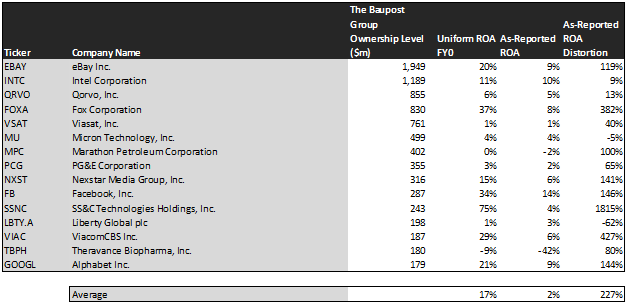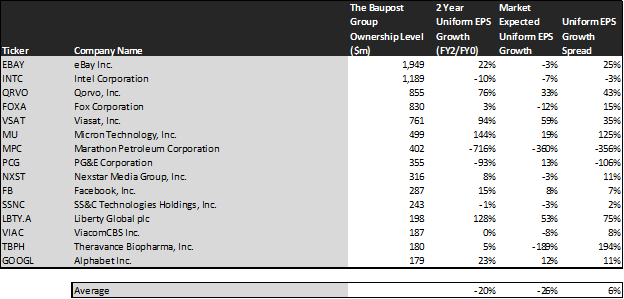No plan survives first contact with the enemy, unless you are the Baupost Group

Last May, we took a look at a hedge fund manager who took the grandfather of value investing’s teachings, and expanded them to generate impressive returns.
He is a rare success story of someone who called their own shot. Seth Klarman said how he was going to beat the market, before going on to beat the market for over 30 years.
Below is the story we told about him in May, including an updated portfolio analysis for his Baupost Group fund, based on his fund’s latest 13-F.
In addition to examining the portfolio, we’re including a deeper look into the fund’s largest current holding, providing you with the current Uniform Accounting Performance and Valuation Tearsheet for that company.
Investor Essentials Daily:
Friday Uniform Portfolio Analytics
Powered by Valens Research
After an eventful Q1 earnings season, we felt it was time to revisit our analysis of Baupost’s portfolio.
Seth Klarman is one of the few managers who actually managed to call his shot. Before becoming one of the best fund managers of the generation, Klarman wrote his book Margin of Safety, outlining how he planned on running his fund for sustained outperformance.
Then, he actually did it.
Below you will find our original report on The Baupost Group with an updated portfolio overview and analysis of how Klarman applied his strategy during the pandemic.
It’s game 3 of the 1932 World Series, and the score is tied 4-4 in the 5th inning.
October baseball is always special, but an at bat in a tied game in the World Series is a true pressure cooker.
Babe Ruth strode to the plate for the Yankees, facing the Chicago Cubs in Wrigley Field.
As he takes strike one, the Cubs bench players are jeering at him and the Wrigleyville faithful are screaming any insult they can think of.
Ruth doesn’t tune them out. Instead, he steps one foot out of the batter’s box and points the head of his bat to the deepest part of center field. He steps back into the box.
He takes strike two.
The fans, the players, the atmosphere only gets louder. They smell blood.
Ruth steps out and, again, uses his bat to point to the Exact. Same. Place. He’s calling his shot!
He steps back into the batter’s box…and Charlie Root throws a curveball that never makes it to the catchers mitt.
Instead it ends up over 440 feet away into the center field stands. Exactly where he said he would.
The Yankees went on to win the game 7-5, and to win the series also. Baseball fans have loved telling that story every day since.
That story has such staying power because of the improbability of it. It’s easy for a pitcher to say after a no-hitter that he felt like something special was going to happen as he warmed up that afternoon.
It’s easy to look back and call David Ortiz one of the most clutch players of all time after he helped the Red Sox win 3 world series. But to be able to call your shot, not just that you were going to get a hit, but that you were going to hit a home run, over right center field, is near impossible.
Which is why it’s so impressive that sixty years later, Seth Klarman did the exact same thing—it’s why he’s a legend in investing, almost to the scale Babe Ruth is in baseball.
Seth Klarman has been a wildly successful investor. His fund Baupost has produced 20% returns a year since 1983. He’s outperformed the market by almost 4x since he started the strategy.
But what’s impressive isn’t just that he has had such phenomenal returns. It’s that he told everyone how he was going to get those returns before he did.
Long before Klarman became a billionaire he wrote a book called Margin of Safety. The name is an homage to Ben Graham’s Security Analysis.
In the book, Klarman laid out his value investing philosophy and how he would pick stocks. He laid out his exact strategy that would eventually lead to Baupost’s phenomenal performance. He called his shot and then he delivered 4x the market’s performance.
Klarman and Baupost are still picking stocks today, and doing an amazing job.
Part of the reason they remain so successful is because Klarman has as much skepticism about as-reported accounting metrics as we do here at Valens.
Klarman has regularly railed against the issues with as-reported accounting metrics. Mocking investors who use metrics like EBIT and EBITDA to value companies, because of how distorted they are.
At Baupost, they are focused on the real operating profitability of companies, not the inaccurate noise of as-reported accounting metrics.
To show how Baupost’s analysis unsurprisingly lines up with Valens Uniform Accounting, we’ve done a high level portfolio audit of Baupost’s current portfolio, based on their most recent 13-F. This is a light version of what we do for our institutional clients when we analyze their portfolios for torpedos and companies they may want to “lean in” on.
See for yourself below.
Using as-reported accounting, investors would think Baupost was not focusing on companies that provided them much margin of safety, given the companies in the portfolio have very weak return on assets (ROA).
On an as-reported basis, many of these companies are poor performers with returns below 5%-6%, and the average as-reported ROA is around 2%.
However, once we make Uniform Accounting (UAFRS) adjustments to accurately calculate earning power, we can see that the returns of the companies in The Baupost Group’s portfolio are much more robust.
The average company in the portfolio displays an impressive average Uniform return on assets (ROA) at 17%. This is well above corporate average returns.
Once the distortions from as-reported accounting are removed, we can realize that SS&C Technologies (SSNC) doesn’t have an ROA of 4%, but returns of 75%. SS&C isn’t a low-return business as shown by wrong data.
Similarly, ViacomCBS’s (VIAC) ROA is really 29%, not 6%. The Baupost Group’s focus on better accounting recognizes a high return business with robust cash flows.
Fox (FOXA) is another great example of as-reported metrics mis-representing the company’s profitability.
The company’s ROA isn’t 8%, it’s actually 37%. Uniform Accounting lines up with The Baupost Group’s decision making that Fox is really a high return business.
The list goes on from there, for names ranging from Google (GOOGL) and Facebook (FB), to eBay (EBAY).
If The Baupost Group’s investment strategy was powered by as-reported metrics, it would never pick most of these companies, because they look like bad companies and poor investments.
To find companies that can deliver alpha beyond the market, just finding companies where as-reported metrics mis-represent a company’s real profitability is insufficient.
To really generate alpha, any investor also needs to identify where the market is significantly undervaluing the company’s potential.
The Baupost Group is also investing in companies that the market has low expectations for, low expectations the companies can exceed.
This chart shows three interesting data points:
- The 2-year Uniform EPS growth represents what Uniform earnings growth is forecast to be over the next two years. The EPS number used is the value of when we take consensus Wall Street estimates and we convert them to the Uniform Accounting framework.
- The market expected Uniform EPS growth is what the market thinks Uniform earnings growth is going to be for the next two years. Here, we show by how much the company needs to grow Uniform earnings in the next 2 years to justify the current stock price of the company. If you’ve been reading our daily analyses and reports for a while, you’ll be familiar with the term embedded expectations. This is the market’s embedded expectations for Uniform earnings growth.
- The Uniform EPS growth spread is the spread between how much the company’s Uniform earnings could grow if the Uniform earnings estimates are right, and what the market expects Uniform earnings growth to be.
The average company in the U.S. is forecast to have 5% annual Uniform Accounting earnings growth over the next 2 years. The Baupost Group’s holdings are forecast by analysts to shrink by 20%.
Even better, the market is pricing these companies to actually shrink earnings by 26% a year on average. While these companies are growing faster than the market, they are intrinsically undervalued, as the market is mispricing their growth by 6%.
These are the kinds of companies that are likely to see their stocks rally when the market realizes growth potential. Without Uniform numbers, investors cannot see the potential of these names.
One example of a company in the portfolio that has growth potential that the market is mispricing is Micron Technology (MU). MU’s analyst forecasts have 144% Uniform earnings growth built in, but the market is pricing the company to have earnings only grow by 19% earnings each year for the next two years.
Another company with similar dislocations is Liberty Global (LBTY.A). Market expectations call for a 53% expansion in earnings. However, the company is actually forecast for Uniform EPS to grow by 128% a year.
Nexstar Media (NXST) is yet another example. The company is priced to shrink by 3% in Uniform earnings, when they are forecast to really grow earnings by 8% a year.
For the most part, The Baupost Group’s holdings are high quality, undervalued portfolios with businesses displaying strong earnings power. This wouldn’t be clear under GAAP, but unsurprisingly Uniform Accounting and a system built to deliver alpha see the same signals.
SUMMARY and eBay Inc. Tearsheet
As The Baupost Group’s largest individual stock holding, we’re highlighting eBay Inc.’s tearsheet today.
As our Uniform Accounting tearsheet for eBay Inc. (EBAY:USA) highlights, eBay’s Uniform P/E trades at 14.1x, which is below the corporate average valuation of 23.7x but around its own historical valuation of 14.3x.
Low P/Es require low EPS growth to sustain them. In the case of eBay, the company has recently shown a 63% Uniform EPS growth.
Wall Street analysts provide stock and valuation recommendations that in general provide very poor guidance or insight. However, Wall Street analysts’ near-term earnings forecasts tend to have relevant information.
We take Wall Street forecasts for GAAP earnings and convert them to Uniform earnings forecasts. When we do this, eBay’s Wall Street analyst-driven forecasts are 29% EPS growth in 2021 and 16% in 2022.
Based on current stock market valuations, we can back into the required earnings growth rate that would justify $55.79 per share. These are often referred to as market embedded expectations.
The company can have Uniform earnings shrink by 3% each year over the next three years and still justify current price levels. What Wall Street analysts expect for eBay’s earnings decline is above what the current stock market valuation requires in 2021 and 2022.
Furthermore, the company’s earning power is 3x the corporate average. Also, cash flows and cash on hand consistently exceed obligations—including debt maturities, capex maintenance, and dividends. Together, this signals a low credit and dividend risk.
To conclude, eBay’s Uniform earnings growth is well above its peer averages, while their valuations are traded well below its average peers.
Best regards,
Joel Litman & Rob Spivey
Chief Investment Strategist &
Director of Research
at Valens Research






